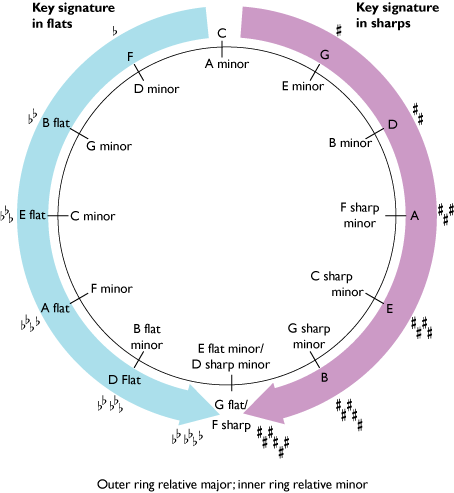6.5 The perfect fifth, the minor third and the circle of fifths
The perfect fifth
While discussing scales, you might have wondered why I described them in the order I chose. From a starting point of C major, the pattern for major scales with sharp key signatures was G, D, A and E, with the key signature for each scale adding an additional sharp to the previous one. The pattern for major scales with flat key signatures was F, B♭, E♭ and A♭, with the key signature for each scale adding an additional flat to the previous one. You might have guessed that this gradual increase in the size of the key signatures governed my choice. And you would have been right.
But my choice was also governed by the related fact that each successive major scale with a sharp key signature starts on the note a perfect fifth above the previous one, and each successive scale with a flat key signature starts on the note a perfect fifth below the previous one. So G major, with one sharp in its key signature, begins on the note a perfect fifth above C, which has no sharps or flats in its key signature. And D major, with two sharps in its key signature, begins on the note a perfect fifth above G. And so on. Conversely, F major, with one flat in its key signature, begins on the note a perfect fifth below C, and B♭ major, with two flats in its key signature, begins on the note a perfect fifth below F. And so on.
This sequence of keys, extended to cover a whole series, is better understood as a diagram, the circle of fifths, shown in Figure 1.
The major keys sit outside the circle and their corresponding relative minors (which have the same key signature) inside the circle. You should take a little time to explore this diagram (although bear in mind that you need a working knowledge of major and minor keys of only up to four sharps and four flats before you start Inside music).
Figure 1 The circle of fifths

The minor third
As you may remember, and as shown in the diagram of the circle of fifths above, the tonic of a relative minor scale can be found by counting down three semitones from the tonic of its major equivalent, for instance, the tonic of C major down to the tonic of A minor. This interval, A–C, consisting of three semitones, we can now name as a minor third.
